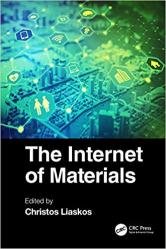The Internet of Materials
- Добавил: literator
- Дата: 25-01-2022, 19:31
- Комментариев: 0
 Название: The Internet of Materials
Название: The Internet of MaterialsАвтор: Christos Liaskos
Издательство: CRC Press
Год: 2021
Страниц: 359
Язык: английский
Формат: pdf (true)
Размер: 61.1 MB
What if the laws of electromagnetism could be customized, rather than being simply adhered to? In recent years, a novel research direction has emerged to explore this direction in the context of wireless communications, exhibiting paradigm-shifting potential, especially in the much anticipated extremely high frequency regime. The present book explores this new direction at an educational level. We hope that the material, though covering multiple disciplines, is fit for newcomers in the field. The book revolves around artificial materials which can sense electromagnetic waves impinging upon them and alter these waves in ways dictated by software. These materials, such as the recently proposed HyperSurfaces concept, can coat common objects such as walls, doors, and sizeable furniture, exerting logical control over the way wireless propagation occurs within an environment overall, e.g., within a building. Thus, the environmental behavior can be dynamically optimized to the needs of wireless devices, such as mobile phones and laptops, offering unprecedented levels of communication range, data transfer rates, energy efficiency, and security.
A core component of HyperSurfaces are the metasurfaces, i.e., planar, artificial structures, which have recently enabled the realization of novel objects with engineered and even unnatural electromagnetic functionalities. Metasurfaces can be designed for any operating frequency and application domain. HyperSurfaces constitute a kind of networked metasurfaces, which can connect to the Internet of Things ecosystem and provide wireless environment optimization under any context. The metasurface functionalities can then be described in software, such as parametric wave steering, absorbing, filtering, and polarizing.
The derived practical benefits are highly promising. Interconnected HyperSurfaces deployed within a space can mitigate previously unsurmountable, degenerative factors in wireless propagation—namely, the path loss, the multi-path fading, and the Doppler shift. This readily allows for lower-power transmissions, which favor the battery lifetime of the wireless devices. Moreover, the decreased scattering reduces cross-device interference, allowing an increased number of mobile users to co-exist in the same space, without degrading their performance. Additionally, the traveling wave reaches the receiver via well-defined paths rather than via multiple echoes, allowing for increased data transmission rates and high-quality coverage even at previously “hidden” areas. From another aspect, this separation of user devices can target increased privacy. Waves carrying sensitive data can be tuned to avoid all other devices apart from the intended recipient, hindering eavesdropping. These interesting environmental behaviors and more can be expressed in software in the form of combinable and reusable modules. Thus, communication system designers and operators are enabled to easily and jointly optimize the complete data delivery process, including the wireless environment, supplementing the customizable wireless device behavior, and, furthermore, reducing the complexity of the device design.
HyperSurfaces stand on the verge of several scientific disciplines, including Materials Physics, Electrical Engineering, Manufacturing of Electronics, Communications, and Computer Science. This book aspires to provide a basic inter-disciplinary scientific background for newcomers, to delve into the resulting new research direction. The chapter structure is as follows:
Chapter 1 Preface
Chapter 2 Introduction
Chapter 3 provides the foundational concepts of electromagnetism that permeate and describe the operation of metasurfaces and metamaterials.
Chapter 4 models the metasurface foundations from the Computer Science aspect, introducing novel software classes that enable the transparent integration of HyperSurfaces into the Internet of Things ecosystem.
Chapter 5 details the network protocols that interconnect the HyperSurfaces and their components to the external world, providing access to their functionalities at the network level.
Chapter 6 details prospectful Internet of Things-compliant approaches for inter-networking metamaterials. Existing solutions in the IoT market are surveyed, from the aspects of hardware, software, and standards.
In Chapter 7, we make a short interim and provide a categorization of the preceding and ensuing chapters in a form of an early protocol stack, in order to facilitate exposition.
Chapter 8 studies the scaling laws of HyperSurfaces, i.e., how their performance, cost, and energy expenditure is scaled versus various factors.
Chapter 9 showcases the Internet of Metamaterials applied to the wireless communications case, with a focus on studying their inter-networking approaches.
Finally, Chapter 10 concludes the book by outlining promising future directions.
Скачать The Internet of Materials
Внимание
Уважаемый посетитель, Вы зашли на сайт как незарегистрированный пользователь.
Мы рекомендуем Вам зарегистрироваться либо войти на сайт под своим именем.
Уважаемый посетитель, Вы зашли на сайт как незарегистрированный пользователь.
Мы рекомендуем Вам зарегистрироваться либо войти на сайт под своим именем.
Информация
Посетители, находящиеся в группе Гости, не могут оставлять комментарии к данной публикации.
Посетители, находящиеся в группе Гости, не могут оставлять комментарии к данной публикации.
